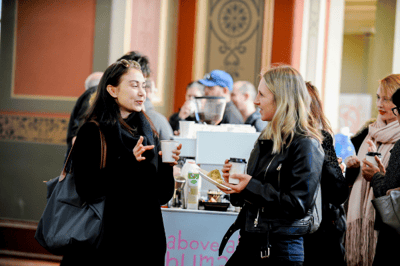Conferences are more than just business. Occurring once or twice a year, they are also a social and networking opportunity for professionals on an international scale, so expectations run high. New conference trends aim to create a fun and engaging experience tailored to the needs of the industry involved. From healthier coffee to persuasive design conferences are moving away from the realm of dreadful business into an almost festival-like atmosphere.

1. Sourcing Local
Going local isn't just for the environmental industry. Many conferences are using food and beverages with ingredients that are locally sourced. This boosts the local economy by creating interest in companies that specialise in locally created fare. Contributing to the local community is also a way to cut costs on transport of supplies and even get some support in case the conference decides to return the following year. Conferences can be unnerving experiences for local businesses, and the more support event planners have, the better. Local sourcing also gives attendees from other countries a chance to experience authentic cuisine and beverages that may not even have been written about.
2. Design is Everything
Even corporate conferences can be stylish and immersive events that focus on atmosphere and provide talking points. After all, many companies have worked hard to ensure their product gets seen, even if only for a few minutes; event planners want to ensure attendees stay mobile and energised as long as possible. Persuasive design, a specific design principle long used in urban planning and advertising, creates the opportunity to keep attendees at events longer than usual, as these stations are typically close enough to the action to provide a good bit of people watching interlaced with access to tea, coffee, and finger foods. The only thing missing? The mobile masseuse.
3. Spatial Contrast
Depending upon where the conference is held, planners are deciding to use conference spaces in creative ways. For convention centres, this might be an unnecessary task as these mammoth spaces are built for many people, but smaller locations call for creativity. Patios and open green spaces are great contrasts to the inside of buildings that typically host conference events for small to mid-sized conferences. Creating spaces designed for food only available at the conference might mean setting up a small kitchen inside with an even bigger food truck area outside. Smoker areas are transformed into places for more intimate group conversation areas, with chairs and tables for discussion. Looking for more info? We break down how to work out the right space here.
4. Creative Coffee Options
There isn't any other fuel of choice for keeping up with all the people, places, and displays that you want to see. In fact, it is essential. Coffee is evolving within the conference scene as well. Australia is considered a leading coffee market, with tons of new innovators reinventing the wheel. In addition to your plan cup of joe, conferences might now start to offer cold-brew, carbonated; even fusion coffees such as Ganoderma coffee are on the rise. If this wasn't enough, coffee combined with beer is now also a thing. With all these options, there really isn't a reason for your attendees to leave.
5. Embrace Technology
A great tool to help manage event registration, ticketing and checking in can be the use of a platform like Eventbrite. In a matter of minutes you can take your event registrants, import them, and create a digital check-in process all within the platform. It’s a whole bunch easier to send an email invite and then scan a QR code upon your delegates arriving. You’ll also have a digital record of who’s attended and who hasn’t that will help you survey and market to your list after the event. Eventbrite is at the base level of technology for ticketing - there are a whole range of other paid and free platforms you can use with a plethora of features like wayfinding, networking, digital agendas and live Q&A. If budget allows and digital engagement is a priority I highly recommend you venture further down this route.
Also consider community based chat for at-the-event communication and broadcasts. You could look at a facebook messenger style platform OR, if the event is tech focussed, create a slack channel with updates on speakers and event movements.
